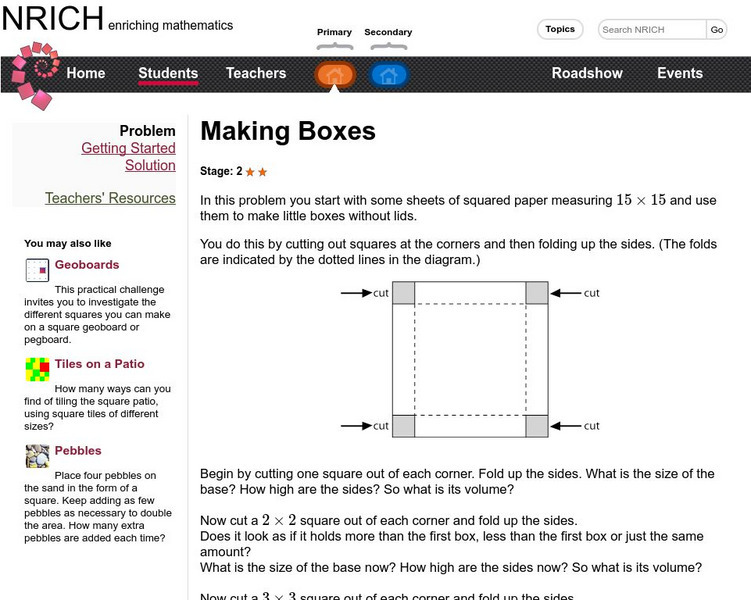Hi, what do you want to do?
Curated OER
Bubble and Boyle
Even middle schoolers still enjoy experimenting with bubbles! They execute a series of experiments enabling them to distinguish between convex and concave surfaces, explore the properties of buoyancy, surface tension, and density,...
Curated OER
Two for One Box Company
Eighth graders experiment to decide if a box that is twice as big holds twice a much. They work the concept of volume and how changing dimensions affect it.
Curated OER
Bubble and Boyle
Middle-schoolers still enjoy playing with bubbles! In this series of eight laboratory activities, science learners explore convex and concave surfaces, angles, gas laws, buoyancy, density and more!
Curated OER
Got Milk?
Students measure the angles of a milk carton. They identify and label acute, right, and obtuse angles. Using appropriate tools, students determine the volume of a cube or a rectangular prism. Students complete worksheets to...
Curated OER
Surface Area
In this geometry instructional activity, 10th graders define surface area, net and lateral face. They calculate the surface areas of cones, prisms and cubes. There are 9 surface area questions.
Curated OER
Polyhedra
Students analyze convex polyhedra through hands on methods. In this geometrical shapes instructional activity, students construct paper models of convex polyhedra and identify the different properties including the number of sides, faces...
Curated OER
Analyzing 3-D Shapes and 2-D Representations
Students can analyze 3-D objects better with actual physical models and by also drawing 2-D representations of them.
Curated OER
Measuring Up To Standards
Fourth graders use Unifix cubes to estimate standard measurements of length, weight, and capacity. After practicing, 4th graders complete an individual assessment by the teacher where they are asked questions about measurement and...
Curated OER
Geometry Journal: Classifying Solids
In this geometry worksheet, 10th graders respond to journal prompts related to prisms and classifying solid shapes. The two page worksheet contains nine questions. Answers are included.
Other
Calculator.net: Volume Calculator
Use these calculator tools to find the volume, in your choice of units, of a sphere, cone, cube, cylinder, rectangular prism, capsule, ball cap, conical frustum, ellipsoid, or square pyramid. Includes a reference section listing formulas...
Other
West Contra Costa Usd: Volume: A Foundation in Unit Cubes [Pdf]
A very detailed lesson on determining the volume of rectangular prisms, teaching students how to derive the formula for volume, and to use it successfully. Plenty of examples, student work, and assessment options.
Other
Calculator.net: Surface Area Calculator
Use these calculator tools to find the surface area, in your choice of units, of a sphere, cone, cube, cylinder, rectangular prism, capsule, ball cap, conical frustum, ellipsoid, or square pyramid. Includes a reference section listing...
National Council of Teachers of Mathematics
Nctm: Illuminations: Cubes
Use this applet to determine the volume of a box by filling it with cubes, rows of cubes, or layers of cubes. Determine the surface area as well by using the box's net.
University of Cambridge
University of Cambridge: Nrich: Making Boxes
Have fun and learn by making a box and then find out its maximum volume as well as other problem-solving activities, including making a table of your results and drawing a graph.















![West Contra Costa Usd: Volume: A Foundation in Unit Cubes [Pdf] Lesson Plan West Contra Costa Usd: Volume: A Foundation in Unit Cubes [Pdf] Lesson Plan](https://static.lp.lexp.cloud/images/attachment_defaults/resource/large/FPO-knovation.png)

